As avid readers we are drawn to books with memorable characters. Here we have stories about animals (we are partial to penguins and frogs) in picture book format for younger readers and stories about young people with whom older readers can vicariously share experiences in both realistic and historical fiction. All of the characters we met in these books are ones we will remember and are eager to introduce to others.
Ages 4–8.
The Infamous Ratsos (Ratso Brothers #1). Kara LeReau. Ill. Matt Myers. 2016. Candlewick.
 According to Louie and Ralphie Ratso’s dad, Big Lou, there are two kinds of people: those who are tough and those who are softies. As Louie and Ralphie strive to be tough by playing pranks, their antics backfire and turn into acts of kindness. For example, when they steal big and brawny Chad Badgerton’s hat, it turns out they’ve rescued little mouse Tiny Crawley’s hat from the classroom bully. After their father receives a letter from the school extolling Louie and Ralphie’s good deeds, he realizes he should try to be more like them. This results in father and sons doing good deeds together that make life a little easier for those around them. Clever cartoonlike drawings add an extra layer of humor to this chapter book for emerging readers.
According to Louie and Ralphie Ratso’s dad, Big Lou, there are two kinds of people: those who are tough and those who are softies. As Louie and Ralphie strive to be tough by playing pranks, their antics backfire and turn into acts of kindness. For example, when they steal big and brawny Chad Badgerton’s hat, it turns out they’ve rescued little mouse Tiny Crawley’s hat from the classroom bully. After their father receives a letter from the school extolling Louie and Ralphie’s good deeds, he realizes he should try to be more like them. This results in father and sons doing good deeds together that make life a little easier for those around them. Clever cartoonlike drawings add an extra layer of humor to this chapter book for emerging readers.
—NB
Nanette’s Baguette. Mo Willems. 2016. Hyperion/Disney.
 Mom sends Nanette to purchase a baguette all on her own for the first time. Along her way to the bakery, Nanette is distracted by seeing friends Georgette, Suzette, and Bret (with his clarinet) and spotting Mr. Barnett walking his pet, Antoinette, whom Nanette stops to pet. Upon remembering her task, Nanette says to the quartet, “Gotta jet! I’ve got a baguette to get.” Arriving at the bakery, Nanette buys “the best baguette yet” from baker Juliette. Of course, Nanette can’t resist the warmth and aroma of the big freshly baked baguette, and one bite leads to another until there is no more baguette. Beset with regret, she confesses to her mother, “I ATE THE BAGUETTE!” Nanette and understanding Mom return to the bakery for another baguette. Willem’s nonstop clever wordplay and creative multimedia illustrations with bright green, pop-eyed cartoon frogs set against detailed backgrounds and judicious use of oversize type make this picture book a surefire read-aloud hit.
Mom sends Nanette to purchase a baguette all on her own for the first time. Along her way to the bakery, Nanette is distracted by seeing friends Georgette, Suzette, and Bret (with his clarinet) and spotting Mr. Barnett walking his pet, Antoinette, whom Nanette stops to pet. Upon remembering her task, Nanette says to the quartet, “Gotta jet! I’ve got a baguette to get.” Arriving at the bakery, Nanette buys “the best baguette yet” from baker Juliette. Of course, Nanette can’t resist the warmth and aroma of the big freshly baked baguette, and one bite leads to another until there is no more baguette. Beset with regret, she confesses to her mother, “I ATE THE BAGUETTE!” Nanette and understanding Mom return to the bakery for another baguette. Willem’s nonstop clever wordplay and creative multimedia illustrations with bright green, pop-eyed cartoon frogs set against detailed backgrounds and judicious use of oversize type make this picture book a surefire read-aloud hit.
—CA
Penguin Problems. Jory John. Ill. Lane Smith. 2016. Random House.
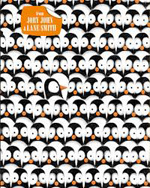 A young penguin wakes up grumpy (“It’s way too early. My beak is cold.”) and goes through the day whining about his penguin problems, including perceived personal shortcomings: He has a silly waddle, he can’t fly, and he looks like everyone else. It’s too much to bear, and he screams, “I have so many problems! And nobody even cares.” Enter a walrus who waxes eloquently on all the good things in the discontented bird’s life. Penguin seems to take the walrus’s words to heart. “Maybe things will work out, after all.” The last page, with Penguin contemplating a heavy nighttime snowfall (“My beak is cold. It gets dark way too early.”) suggests, however, that he will wake up with the same problems and attitude. The book design is fabulous; Smith’s digitally created artwork perfectly matches the humor of John’s brief (except for the walrus’s lengthy unsolicited advice) text.
A young penguin wakes up grumpy (“It’s way too early. My beak is cold.”) and goes through the day whining about his penguin problems, including perceived personal shortcomings: He has a silly waddle, he can’t fly, and he looks like everyone else. It’s too much to bear, and he screams, “I have so many problems! And nobody even cares.” Enter a walrus who waxes eloquently on all the good things in the discontented bird’s life. Penguin seems to take the walrus’s words to heart. “Maybe things will work out, after all.” The last page, with Penguin contemplating a heavy nighttime snowfall (“My beak is cold. It gets dark way too early.”) suggests, however, that he will wake up with the same problems and attitude. The book design is fabulous; Smith’s digitally created artwork perfectly matches the humor of John’s brief (except for the walrus’s lengthy unsolicited advice) text.
—CA
Sam the Man & the Chicken Plan. Frances O’Roark Dowell. Ill. Amy June Bates. 2016. Caitlyn Dlouhy/Atheneum/Simon & Schuster.
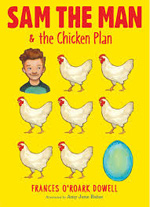 Sam is a 7-year-old boy in want of a job. After Mrs. Kerner hires him to take care of her chickens for a few days, Sam decides to go into the chicken business. He borrows money from his father to buy Helga, a chicken that lays blue eggs, and arranges to keep it in Mrs. Kerner’s coop. To repay his father, Sam agrees to walk a grumpy elderly neighbor, Mr. Stockfish, at two dollars a walk. After Sam invites him to watch Helga lay a blue egg, Mr. Stockfish can’t wait to walk to the coop every day. When Sam takes Helga’s first egg to show-and-tell, Mr. Pell, his teacher, demonstrates how to get the egg out without breaking the shell. Between selling blue eggshells to classmates for fifty cents each and walking Mr. Stockfish, it won’t be long before the young entrepreneur can buy another chicken! Pencil sketches add interest to this first book in a new chapter book series for beginning readers.
Sam is a 7-year-old boy in want of a job. After Mrs. Kerner hires him to take care of her chickens for a few days, Sam decides to go into the chicken business. He borrows money from his father to buy Helga, a chicken that lays blue eggs, and arranges to keep it in Mrs. Kerner’s coop. To repay his father, Sam agrees to walk a grumpy elderly neighbor, Mr. Stockfish, at two dollars a walk. After Sam invites him to watch Helga lay a blue egg, Mr. Stockfish can’t wait to walk to the coop every day. When Sam takes Helga’s first egg to show-and-tell, Mr. Pell, his teacher, demonstrates how to get the egg out without breaking the shell. Between selling blue eggshells to classmates for fifty cents each and walking Mr. Stockfish, it won’t be long before the young entrepreneur can buy another chicken! Pencil sketches add interest to this first book in a new chapter book series for beginning readers.
—NB
Ages 9–11
Beautiful Blue World. Suzanne LaFleur. 2016. Wendy Lamb/Random House.
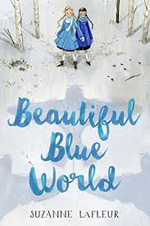 Twelve-year-old Mathilde’s country of Sofarende is at war. With mixed feelings, Mathilde takes the aptitude test for recruitment into a secret government program. She’s reluctant to be separated from her family but knows that the stipend they will receive will help them survive. Once at Faetre, a facility housing a talented group of children aiding military strategists, Mathilde is convinced a mistake was made. She believes that it is because she isn’t clever enough to do anything useful that she is assigned to spend each day just talking with a young prisoner of war. As days go by, she realizes that they share similar feelings toward the war. When the war reaches Faetre, the children are evacuated. Mathilde fears that the prisoner will die—either when his country bombs Faetre or if Sofarende burns down the facility to keep it out of the hands of the enemy without releasing him. The ending leaves readers eager for the next book in the series.
Twelve-year-old Mathilde’s country of Sofarende is at war. With mixed feelings, Mathilde takes the aptitude test for recruitment into a secret government program. She’s reluctant to be separated from her family but knows that the stipend they will receive will help them survive. Once at Faetre, a facility housing a talented group of children aiding military strategists, Mathilde is convinced a mistake was made. She believes that it is because she isn’t clever enough to do anything useful that she is assigned to spend each day just talking with a young prisoner of war. As days go by, she realizes that they share similar feelings toward the war. When the war reaches Faetre, the children are evacuated. Mathilde fears that the prisoner will die—either when his country bombs Faetre or if Sofarende burns down the facility to keep it out of the hands of the enemy without releasing him. The ending leaves readers eager for the next book in the series.
—CA
Framed! (T.O.A.S.T.* Mystery #1).James Ponti. 2016. Aladdin/Simon & Schuster.
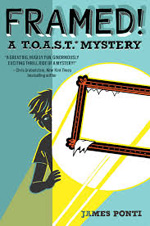 Twelve-year-old Florian Bates is the inventor of T.O.A.S.T. (Theory of All Small Things), a technique of making close observations. When he meets Margaret, his new neighbor, he introduces her to T.O.A.S.T., and they open a detective agency. Their first job is to find Margaret’s birth parents. Their attention, however, is quickly diverted to the National Gallery of Art in Washington, DC, where his parents work. Florian and Margaret practice T.O.A.S.T. on an artist who is painting a replica of a Monet masterpiece. After several paintings are stolen, including the Monet, and Florian solves the case with his Sherlock Holmes–like observation skills, he is hired as a “covert asset” by the FBI. But the case isn’t over yet, and Florian is kidnapped by Romanian Mafia mob boss Nic the Knife. Refocusing on observation of small things, Florian realizes that his conclusions, based on misdirection, have thrust him into dangers, setting readers up for the next book.
Twelve-year-old Florian Bates is the inventor of T.O.A.S.T. (Theory of All Small Things), a technique of making close observations. When he meets Margaret, his new neighbor, he introduces her to T.O.A.S.T., and they open a detective agency. Their first job is to find Margaret’s birth parents. Their attention, however, is quickly diverted to the National Gallery of Art in Washington, DC, where his parents work. Florian and Margaret practice T.O.A.S.T. on an artist who is painting a replica of a Monet masterpiece. After several paintings are stolen, including the Monet, and Florian solves the case with his Sherlock Holmes–like observation skills, he is hired as a “covert asset” by the FBI. But the case isn’t over yet, and Florian is kidnapped by Romanian Mafia mob boss Nic the Knife. Refocusing on observation of small things, Florian realizes that his conclusions, based on misdirection, have thrust him into dangers, setting readers up for the next book.
—NB
Ages 12–14
Perfect Liars. Kimberly Reid. 2016. Tu/Lee & Low.
 Andrea (“Drea”) Faraday is considered smart, rich, and privileged, but she is also the child of grifters posing as legitimate antique collectors. During the exclusive Woodruff School’s Welcome Back Gala, a heist extraordinaire occurs. Drea and her brother, Damon, a rookie patrol officer, suspect their parents, who take off to Europe. Drea’s perfect behavior crumbles with shoplifting and a grade that eliminates her chance of becoming valedictorian. Attempting to break into Woodruff to change that grade, she runs into Xavier and Jason in a breaking and entering of their own. Only the boys are caught and detained. Drea is rescued by her brother, who signs her up to tutor at Justice Academy, where she once again runs into juvies Xavier and Jason—and a former acquaintance, Gigi. Drea soon realizes that there isn’t much difference between herself and them. When these teens band together to fight a common enemy, everything changes. Readers will enjoy the rich diversity of the main characters in this mystery.
Andrea (“Drea”) Faraday is considered smart, rich, and privileged, but she is also the child of grifters posing as legitimate antique collectors. During the exclusive Woodruff School’s Welcome Back Gala, a heist extraordinaire occurs. Drea and her brother, Damon, a rookie patrol officer, suspect their parents, who take off to Europe. Drea’s perfect behavior crumbles with shoplifting and a grade that eliminates her chance of becoming valedictorian. Attempting to break into Woodruff to change that grade, she runs into Xavier and Jason in a breaking and entering of their own. Only the boys are caught and detained. Drea is rescued by her brother, who signs her up to tutor at Justice Academy, where she once again runs into juvies Xavier and Jason—and a former acquaintance, Gigi. Drea soon realizes that there isn’t much difference between herself and them. When these teens band together to fight a common enemy, everything changes. Readers will enjoy the rich diversity of the main characters in this mystery.
—NB
A Tyranny of Petticoats: 15 Stories of Belles, Bank Robbers & Other Badass Girls. Jessica Spotswood (Ed.). 2016. Candlewick.
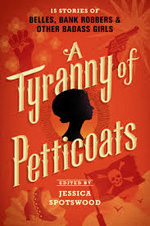 For this anthology, 15 YA authors contributed well-crafted historical fiction and historical fantasy stories about a diverse group of clever, adventurous American girls with strong voices. Reading the stories, organized chronologically (1710–1968) and set in various locales, takes teens on an historical journey across America. A note at the end of each story provides information on its background and the author’s inspiration. Picking a favorite story is difficult; mine is Saundra Mitchell’s “Bonnie and Clyde,” set in Swan’s Holler, IN, in 1934. Keeping her identity secret by exchanging petticoats for pants, Baby Boy Wabash, who robs banks, tells of getting her first gunshot wound as she eludes the law once again on the day she hears that Bonnie Parker and Clyde Barrow have been killed.
For this anthology, 15 YA authors contributed well-crafted historical fiction and historical fantasy stories about a diverse group of clever, adventurous American girls with strong voices. Reading the stories, organized chronologically (1710–1968) and set in various locales, takes teens on an historical journey across America. A note at the end of each story provides information on its background and the author’s inspiration. Picking a favorite story is difficult; mine is Saundra Mitchell’s “Bonnie and Clyde,” set in Swan’s Holler, IN, in 1934. Keeping her identity secret by exchanging petticoats for pants, Baby Boy Wabash, who robs banks, tells of getting her first gunshot wound as she eludes the law once again on the day she hears that Bonnie Parker and Clyde Barrow have been killed.
—CA
Ages 15+
Tell Me Something Real. Calla Devlin. 2016. Atheneum/Simon & Schuster.
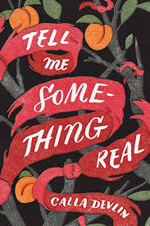 Narrator Vanessa Babcock is the responsible middle child in a family living in San Diego in 1976. While their father slaves away under a boss who won’t give him time off to attend to family medical needs, the sisters accompany their terminally ill mother to experimental Laetrile treatment sessions at a clinic across the border in Tijuana, Mexico. There they meet 16-year-old Caleb, also in treatment, and his mother, Barb, who are from Seattle. When Caleb and Barb come to live with them to be closer to the clinic, Barb brings a much-needed sense of normalcy to Vanessa’s family until something inexplicable happens, and she and her son leave in a hurry. In this beautifully written book about issues relating to death and loss, the unique bonds of siblings, and the stirrings of first love, Vanessa must face secrets and, ultimately, a family betrayal beyond imagination if she is to figure out how to move forward with her life.
Narrator Vanessa Babcock is the responsible middle child in a family living in San Diego in 1976. While their father slaves away under a boss who won’t give him time off to attend to family medical needs, the sisters accompany their terminally ill mother to experimental Laetrile treatment sessions at a clinic across the border in Tijuana, Mexico. There they meet 16-year-old Caleb, also in treatment, and his mother, Barb, who are from Seattle. When Caleb and Barb come to live with them to be closer to the clinic, Barb brings a much-needed sense of normalcy to Vanessa’s family until something inexplicable happens, and she and her son leave in a hurry. In this beautifully written book about issues relating to death and loss, the unique bonds of siblings, and the stirrings of first love, Vanessa must face secrets and, ultimately, a family betrayal beyond imagination if she is to figure out how to move forward with her life.
—NB
Whisper to Me. Nick Lake. 2016. Bloomsbury.
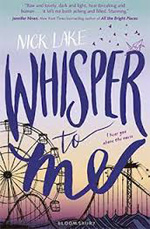 In a long e-mail to the boy whose heart she broke, Cassie begs forgiveness and urges him to meet her at the pier at 5 p.m., Friday. The summer had begun with a jolt when she found a girl’s foot on the beach, possible evidence of a murder by the Houdini Killer, who is targeting sex workers. This discovery triggered within Cassie the “voice” of an angry woman who began directing Cassie’s actions (…slap yourself, twice, hard!). Surprisingly, the voice was silent when she was with the boy, but she can’t tell him about the voice—or the tragedy seven years ago, when her mother died in her arms. However, when Cassie’s father, an ex-Navy SEAL with PTSD, forbids her to spend time with the boy, life spirals out of control. Through therapy, Cassie confronts the voice and comes to grips with loss and relationships. This book sheds light on how an individual’s mental illness, with its symptoms and treatments, affects family and friends.
In a long e-mail to the boy whose heart she broke, Cassie begs forgiveness and urges him to meet her at the pier at 5 p.m., Friday. The summer had begun with a jolt when she found a girl’s foot on the beach, possible evidence of a murder by the Houdini Killer, who is targeting sex workers. This discovery triggered within Cassie the “voice” of an angry woman who began directing Cassie’s actions (…slap yourself, twice, hard!). Surprisingly, the voice was silent when she was with the boy, but she can’t tell him about the voice—or the tragedy seven years ago, when her mother died in her arms. However, when Cassie’s father, an ex-Navy SEAL with PTSD, forbids her to spend time with the boy, life spirals out of control. Through therapy, Cassie confronts the voice and comes to grips with loss and relationships. This book sheds light on how an individual’s mental illness, with its symptoms and treatments, affects family and friends.
—NB
Nancy Brashear is Professor Emeritus of English from Azusa Pacific University, in Azusa, CA. Carolyn Angus is former director of the George G. Stone Center for Children's Books, Claremont Graduate University, in Claremont, CA.
These reviews are submitted by members of the International Literacy Association's Children's Literature and Reading Special Interest Group (CL/R SIG) and are published weekly on Literacy Daily
.